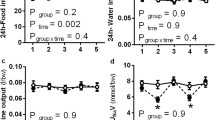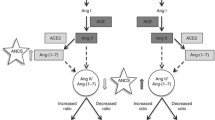Abstract
Objectives
The controversy regarding potential long-term side effects of antenatal steroid administration for accelerating fetal lung maturation is still unresolved despite more than 30 years of experience. Studies in animals have demonstrated that administration of glucocorticoids during pregnancy alters renal expression of several key regulatory molecules at different developmental stages followed in most cases with the development of hypertension in the adult. We studied the effects of betamethasone on the expression of (1) NA,K-ATPAse pump; (2) the Na/H exchanger 3 (NAHE3); (3) angiotensin receptor (AT1 and AT2); and (4) the type 1 dopamine receptor (DIR).
Methods
Pregnant sheep were treated with either 0.17 mg/kg betamethasone or vehicle 24 hours apart at 80 and 81 days’ gestation. Fetal kidneys were harvested at 81 and 135 days’ gestation. Protein and mRNA levels were measured in kidney cortex.
Results
Betamethasone had acute and long-term effects on fetal kidney cortex gene expression. Acutely, mRNA abundance for AT2 was significantly lower and that of NHE3 significantly higher than in controls (0.4 ± 0.02 vs 0.7 ± 0.05; 1.2 ± 0.16 vs 0.4 ± 0.04; P <.05). At 135 days’ gestation, AT2 receptor abundance remained lower than control (0.2 ± 0.02 vs 0.4 ± 0.02; P <.05), whereas D1R expression was higher (0.8 ± 0.17 vs 0.5 ± 0.06; P <.05). No changes in NayK-ATPase of AT1 receptor at either of the two time points studied were observed. Antenatal steroid administration was not associated with premature labor or a reduction in either body weight or kidney weight.
Conclusion
Our findings strongly suggest that antenatal glucocorticoid administration according to National Institutes of Health (NIH) consensus guidelines may alter human fetal renal development. Further studies are needed to establish a direct relationship between alterations in fetal renal gene expression and the development of hypertension in adulthood.
Similar content being viewed by others
References
Liggins GC, Howie RN. A controlled trial of antepartum glucocorticoid treatment for prevention of the respiratory distress syndrome in premature infants. Pediatrics 1972;50:515–25.
Jobe AH. Glucocorticoids in perinatal medicine: Misguided rockets? J Pediatr 2000;137:1–3.
Leviton LC, Goldenberg RL, Baker CS, et al. Methods to encourage the use of antenatal corticosteroid therapy for fetal maturation: A randomized controlled trial. JAMA 1999;281:46–52.
Doyle LW, Ford GW, Davis NM, Callanan C. Antenatal corticosteroid therapy and blood pressure at 14 years of age in preterm children. Clin Sci 2000;98:137–42.
Dalziel SR, Walker NK, Parag V, et al. Cardiovascular risk factors after antenatal exposure to betamethasone: 30-year follow-up of a randomised controlled trial. Lancet 2005;365:1856–62.
NIH Consensus Development Panel on the Effect of Corticosteroids for Fetal Maturation on Perinatal Outcomes. Effect of conrticosteroids for fetal maturation on perinatal outcomes. JAMA 1995;273:413–418.
Celsi G, Kistner A, Aizman R, et al. Prenatal dexamethasone causes oligonephronia, sodium retention, and higher blood pressure in the offspring. Pediatr Res 1998;44:317–22.
Ortiz LA, Quan A, Weinberg A, Baum M. Effect of prenatal dexamethasone on rat renal development. Kidney Int 2001;59:1663–9.
Dodic M, May CN, Wintour EM, Coghlan JP. An early prenatal exposure to excess glucocorticoid leads to hypertensive offspring in sheep. Clin Sci 1998;94:149–55.
Dodic M, Abouantoun T, O’Connor A, Wintour EM, Moritz KM. Programming effects of short prenatal exposure to dexamethasone in sheep. Hypertension 2002;40:729–34.
Dodic M, Hantzis V, Duncan J, et al. Programming effects of short prenatal exposure to cortisol. FASEB J 2002;16:1017–26.
Nwagwu MO, Cook A, Langley-Evans SC. Evidence of progressive deterioration of renal function in rats exposed to a material low-protein diet in utero. Br J Nutr 2000;83:79–85.
Langley-Evans SC, Welham SJ, Jackson AA. Fetal exposure to a maternal low protein diet impairs nephrogenesis and promotes hypertension in the rat. Life Sci 1999;64:965–74.
Wintour EM, Johnson K, Koukoulas I, Moritz K, Tersteeg M, Dodic M. Programming the cardiovascular system, kidney and the brain—A review. Placenta 2003;24:S65–71.
Wintour EM, Moritz KM, Johnson K, Ricardo S, Samuel CS, Dodic M. Reduced nephron number in adult sheep, hypertensive as a result of prenatal glucocorticoid treatment. J Physiol (Lond) 2003;549:929–35.
Figueroa JP, Rose JC, Massmann GA, Zhang J, Acuna G. Alterations in fetal kidney development and elevations in arterial blood pressure in young adult sheep after clinical doses of antenatal glucocorticoids. Pediatr Res 2005;58:510–5.
Schnermann J. NaCl transport deficiencies—Hemodynamics to the rescue. Pflugers Arch 2000;439:682–90.
Wang ZQ, Felder RA, Carey RM. Selective inhibition of the renal dopamine subtype D1A receptor induces antinatriuresis in conscious rats. Hypertension 1999;33:504–10.
Mackenzie HS, Brenner BM. Fewer nephrons at birth: A missing link in the etiology of essential hypertension? Am J Kidney Dis 1995;26:91–8.
Brenner BM. The etiology of adult hypertension and progressive renal injury: An hypothesis. Bull Mem Acad R Med Belg 1994;149:121–5.
Robillard JE, Page WV, Mathews MS, Schutte BC, Nuyt AM, Segar JL. Differential gene expression and regulation of renal angiotensin II receptor subtypes (AT1 and AT2) during fetal life in sheep. Pediatr Res 1995;38:896–904.
Kijima K, Matsubara H, Murasawa S, Maruyama K, Mon Y, Inada M. Gene transcription of angiotensin II type 2 receptor is repressed by growth factors and glucocorticoids in PC12 cells. Biochem Biophys Res Commun 1995;216:359–66.
Ozono R, Wang ZQ, Moore AF, Inagami T, Siragy HM, Carey RM. Expression of the subtype 2 angiotensin (AT2) receptor protein in rat kidney. Hypertension 1997;30:1238–46.
Gimonet V, Bussieres L, Medjebeur AA, Gasser B, Lelongt B, Laborde K. Nephrogenesis and angiotensin II receptor subtypes gene expression in the fetal lamb. Am J Physiol 1998;274:F1062–9.
Butkus A, Albiston A, Alcorn D, et al. Ontogeny of angiotensin II receptors, types 1 and 2, in ovine mesonephros and metanephros. Kidney Int 1997;52:628–36.
Schutz S, Le M, Corvol P, Gasc JM. Early expression of all the components of the renin-angiotensin-system in human development. Am J Pathol 1996;149:2067–79.
Arima S, Endo Y, Yaoita H, et al. Possible role of P-450 metabolite of arachidonic acid in vasodilator mechanism of angiotensin II type 2 receptor in the isolated microperfused rabbit afferent arteriole. J Clin Invest 1997;100:2816–23.
Kohagura K, Arima S, Endo Y, et al. Involvement of cytochromie P450 metabolites in the vascular action of angiotensin II on the afferent arterioles. Hypertens Res 2001;24:551–7.
Hein L, Barsh GS, Pratt RE, Dzau VJ, Kobika BK. Behavioural and cardiovascular effects of disrupting the angiotensin II type-2 receptor in mice. Nature 1995;377:744–7.
Ichiki T, Labosky PA, Shiota C, et al. Effects on blood pressure and exploratory behaviour of mice lacking angiotensin II type-2 receptor. Nature 1995;377:748–50.
Endo Y, Arima S, Yaoita H, Tsunoda K, Omata K, Ito S. Vasodilation mediated by angiotensin II type 2 receptor is impaired in afferent arteriolesof young spontaneously hypertensive rats. J Vasc Res 1998;35:421–7.
Goto M, Mukoyama M, Sugawara A, et al. Expression and role of angiotensin II type 2 receptor in the kidney and mesangial cells of spontaneously hypertensive rats. Hypertens Res 2002;25:125–33.
Moritz KM, Boon WM, Wintour EM. Glucocorticoid programming of adult disease. Cell Tissue Res 2005;322:81–8.
Chen K, Carey LC, Liu J, Valego NK, Tatter SB, Rose JC. The effect of hypothalamo-pituitary disconnection on the renin-angiotensin system in the late-gestation fetal sheep. AJP Regul Integrative Comparative Physiol 2005;288:R1279–87.
Guillery EN, Karniski LP, Mathews MS, et al. Role of glucocorticoids in the maturation of renal cortical Na+/H+ exchanger activity during fetal life in sheep. Am J Physiol 1995;268:F710–17.
Bobulescu IA, Dwarakanath V, Zou L, Zhang J, Baum M, Moe OW. Glucocorticoids acutely increase cell surface Na+/H+ exchanger-3 (NHE3) by activation of NHE3 exocytosis. Am J Physiol Renal Physiol 2005;289:F685–91.
Cheung PY, Barrington KJ. Renal dopamine receptors: Mechanisms of action and developmental aspects. Cardiovasc Res 1996;31:2–6.
Nakamura KT, Felder RA, Jose PA, Robillard JE. Effects of dopamine in the renal vascular bed of fetal, newborn, and adult sheep. Am J Physiol 1987;252:R490–7.
Felder RA, Nakamura KT, Robillard JE, Kanadjian M, Jose PA. Dopamine receptors in the developing sheep kidney. Pediatr Nephrol 1988;2:156–62.
Kinoshita S, Felder RA. Ontogeny of DA1 receptor-adenylate cyclase coupling in proximal convoluted tubules. Am J Physiol 1990;259:F971–6.
Brismar H, Asghar M, Carey RM, Greengard P, Aperia A. Dopamine-induced recruitment of dopamine D1 receptors to the plasma membrane. Proc Natl Acad Sci U S A 1998;95:5573–8.
Author information
Authors and Affiliations
Corresponding author
Additional information
Supported by Grant No. HL68728 from the National Institutes of Health.
Rights and permissions
About this article
Cite this article
Massmann, G.A., Zhang, J., Rose, J.C. et al. Acute and Long-Term Effects of Clinical Doses of Antenatal Glucocorticoids in the Developing Fetal Sheep Kidney. Reprod. Sci. 13, 174–180 (2006). https://doi.org/10.1016/j.jsgi.2006.01.005
Published:
Issue Date:
DOI: https://doi.org/10.1016/j.jsgi.2006.01.005




